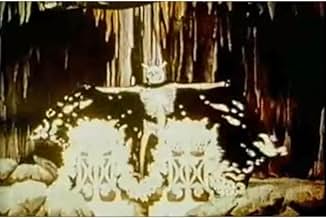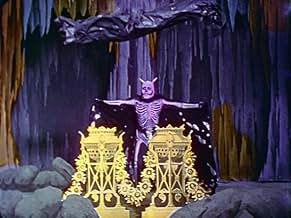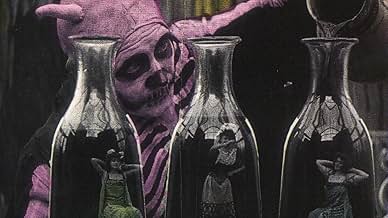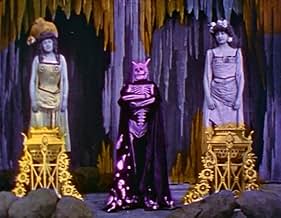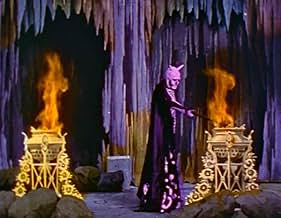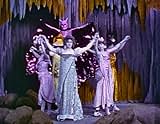IMDb RATING
6.5/10
1.3K
YOUR RATING
A demonic magician attempts to perform his act in a strange grotto, but is confronted by a Good Spirit who opposes him.A demonic magician attempts to perform his act in a strange grotto, but is confronted by a Good Spirit who opposes him.A demonic magician attempts to perform his act in a strange grotto, but is confronted by a Good Spirit who opposes him.
Featured reviews
If you've seen any of Georges Melies films there probably isn't anything here that you haven't seen before and, apart from one brief sequence, this film is pretty dull as a result.
The film takes place in an underground cavern where a skeletal demon amuses himself by conjuring up a couple of hypnotised girls whom he wraps in plastic sheet before levitating them. The sheets burst into flames as they hover before the demon makes them disappear. A good spirit then appears to repeatedly spoil the demon's fun. This goes on for the best part of ten minutes and, to be honest, it gets a little tedious after a while.
The one good sequence comes when the demon places three jars on a table then carries the table towards the camera. It's an unusual shot for 1907 and is quite effective - as is the demon's make-up.
The film takes place in an underground cavern where a skeletal demon amuses himself by conjuring up a couple of hypnotised girls whom he wraps in plastic sheet before levitating them. The sheets burst into flames as they hover before the demon makes them disappear. A good spirit then appears to repeatedly spoil the demon's fun. This goes on for the best part of ten minutes and, to be honest, it gets a little tedious after a while.
The one good sequence comes when the demon places three jars on a table then carries the table towards the camera. It's an unusual shot for 1907 and is quite effective - as is the demon's make-up.
In the late 19th and early 20th century, Georges Méliès was a very successful filmmaker. Much of it was because Méliès was originally a stage magician and he thought like one when making films. As a result, many of his films look like magic shows and the director used a lot of camera tricks to make things seemingly appear and disappear. Soon, others began copying his films....and among them, the Spaniard, Segundo de Chomón, was among the best....though his versions of the great master's films often were second-rate in quality.
"Le Spectre Rouge" is one of the best Chomón films to watch. This is because he crams every sort of camera trick into the film plus it's all in the form of a magic show. And, to get it all there, the film is about 9 minutes in length....which is amazingly long when the average movie was about one to two minutes long! As a result, you get a great homage to Méliès...one where you can see a lot of film footage showing his techniques which Chomón copied. This footage is all in the form of a weird caped skeleton-demon performing magic tricks until the tables are turned on him.
As far as how watchable all this is, it depends on you. If you love very, very early films by all means watch. Otherwise, you might find it tough going even if the film is technically brilliant.
"Le Spectre Rouge" is one of the best Chomón films to watch. This is because he crams every sort of camera trick into the film plus it's all in the form of a magic show. And, to get it all there, the film is about 9 minutes in length....which is amazingly long when the average movie was about one to two minutes long! As a result, you get a great homage to Méliès...one where you can see a lot of film footage showing his techniques which Chomón copied. This footage is all in the form of a weird caped skeleton-demon performing magic tricks until the tables are turned on him.
As far as how watchable all this is, it depends on you. If you love very, very early films by all means watch. Otherwise, you might find it tough going even if the film is technically brilliant.
The Red Spectre (1907)
** 1/2 (out of 4)
Mildly entertaining French film from director Ferdinand Zecca was clearly influenced by the work of Georges Melies. In this film, in what appears to be Hell or something like it, a skeleton brings to life a couple women and then begins to do various tricks with them. That's pretty much everything you need to know in regards to the story as everything else is just one trick after another. There are a few good things about this film but at the same time it's just so easy to see that it's no where near the league of Melies and you have to feel that the French master was doing this type of film a decade earlier and doing it much better. I think the biggest problem is that there's really no strong pacing and after a while the 9-minute running time just feels like it's dragging along. There are several of the tricks, which simply aren't that entertaining and for one good example just check out the one where the skeleton wraps a woman up in some sort of tarp. How the trick was done is easy to spot. There are some good things however and this includes the scenery, which is quite nice to look at. The biggest highlight has to be the very good tinting and especially the reds.
** 1/2 (out of 4)
Mildly entertaining French film from director Ferdinand Zecca was clearly influenced by the work of Georges Melies. In this film, in what appears to be Hell or something like it, a skeleton brings to life a couple women and then begins to do various tricks with them. That's pretty much everything you need to know in regards to the story as everything else is just one trick after another. There are a few good things about this film but at the same time it's just so easy to see that it's no where near the league of Melies and you have to feel that the French master was doing this type of film a decade earlier and doing it much better. I think the biggest problem is that there's really no strong pacing and after a while the 9-minute running time just feels like it's dragging along. There are several of the tricks, which simply aren't that entertaining and for one good example just check out the one where the skeleton wraps a woman up in some sort of tarp. How the trick was done is easy to spot. There are some good things however and this includes the scenery, which is quite nice to look at. The biggest highlight has to be the very good tinting and especially the reds.
The first decade of the twentieth century saw the production of dozens of brief "trick films" which pushed the boundaries of the new medium, and France was the capital of this activity. Georges Méliès is the best known creator of these films, but The Red Spectre, which was produced at the Pathé Studio as a collaboration between Méliès' fellow pioneers Ferdinand Zecca and Segundo De Chomon, is perhaps the most bizarre and fascinating of them all. Or at least, allowing for the fact that so many of these films are lost, it certainly ranks with the best of the survivors. It is better seen than described, genuinely dreamlike in its images and transitions, and quite strange, but quite satisfying as well. The action lasts only about 8 or 9 minutes, but when it's over you feel as if you've been permitted to visit another world. When The Red Spectre was first exhibited the black & white footage was hand-colored to produce a dazzling effect, and happily, this material survives: a color print was discovered in a junk-yard in Mexico, and purchased for $25.00!
Our setting is a mysterious underground grotto, and our "host" is a demonic magician who seems to be toying with the souls or spirits of several captive women. He causes them to levitate, then burst into flames; he captures their ashes in bottles, brings them back to life in miniaturized form, etc. The magician is opposed throughout by a Good Fairy who resembles Peter Pan (portrayed by a woman, as Peter traditionally is on stage). The precise meaning of the action is difficult to determine at times, but the central conflict amounts to a struggle between the forces of Good and Evil.
One effect is especially notable: when the wicked magician produces three glass bottles, each holding a tiny woman prisoner, and brings them downstage to allow for a close-up, the scene instantly reminds latter day viewers of a similar sequence in The Bride of Frankenstein (1935). Did James Whale see this film, or is the similarity a coincidence? Notable, too, is the depiction of a device very much like television-- strongly suggested by the evil conjurer's magic screens, each of which depicts a series of moving images. Here's a real cinematic milestone: a film that predicts the coming of T.V., and, on top of that, attributes its invention to a demon!
Our setting is a mysterious underground grotto, and our "host" is a demonic magician who seems to be toying with the souls or spirits of several captive women. He causes them to levitate, then burst into flames; he captures their ashes in bottles, brings them back to life in miniaturized form, etc. The magician is opposed throughout by a Good Fairy who resembles Peter Pan (portrayed by a woman, as Peter traditionally is on stage). The precise meaning of the action is difficult to determine at times, but the central conflict amounts to a struggle between the forces of Good and Evil.
One effect is especially notable: when the wicked magician produces three glass bottles, each holding a tiny woman prisoner, and brings them downstage to allow for a close-up, the scene instantly reminds latter day viewers of a similar sequence in The Bride of Frankenstein (1935). Did James Whale see this film, or is the similarity a coincidence? Notable, too, is the depiction of a device very much like television-- strongly suggested by the evil conjurer's magic screens, each of which depicts a series of moving images. Here's a real cinematic milestone: a film that predicts the coming of T.V., and, on top of that, attributes its invention to a demon!
Here's Segundo de Chomon challenging Melies as the master of the trick film, using the sort of magician's act that Melies did. It's a combination of stage magic and movie magic -- if you look carefully, you can see the moments when the camera stops and something is substituted.
Because whenever Melies got before the cameras and did his act -- he was a stage magician and had gotten into making movies to fill up the show at his Theatre Robert-Houdin -- you could see his pleasure in performing, there was no way that de Chomon could match that. So he stuck his unnamed performing in a skeleton costume with horns and a cape. It's so over-the-top that it's magnificent.
Because whenever Melies got before the cameras and did his act -- he was a stage magician and had gotten into making movies to fill up the show at his Theatre Robert-Houdin -- you could see his pleasure in performing, there was no way that de Chomon could match that. So he stuck his unnamed performing in a skeleton costume with horns and a cape. It's so over-the-top that it's magnificent.
Did you know
- TriviaHas a link to the Ulli Lommel's Zodiac Killer (2005) case. A letter allegedly sent by the Zodiac Killer, who may have been a film buff, was signed "The Red Phantom" and could have referred to this film or to the color "Masque of the Red Death" sequence in Lon Chaney's 1925 Le Fantôme de l'opéra (1925).
- ConnectionsFeatured in Hollywood (1980)
Details
- Release date
- Country of origin
- Languages
- Also known as
- The Red Spectre
- Production company
- See more company credits at IMDbPro
- Runtime
- 9m
- Color
- Sound mix
- Aspect ratio
- 1.33 : 1
Contribute to this page
Suggest an edit or add missing content

